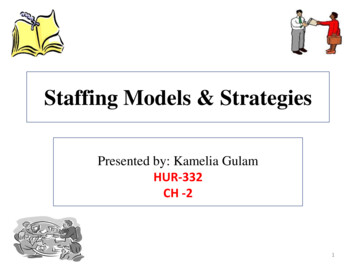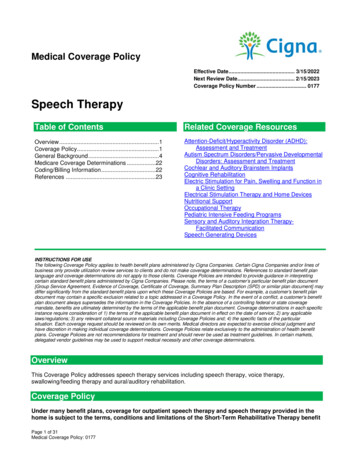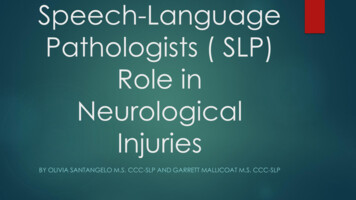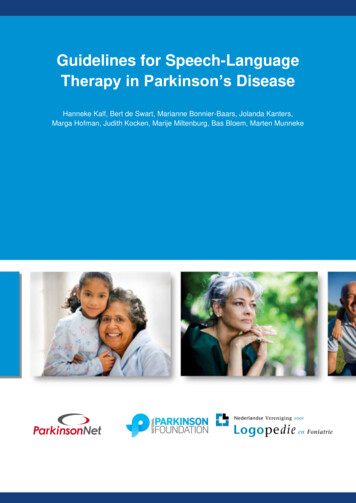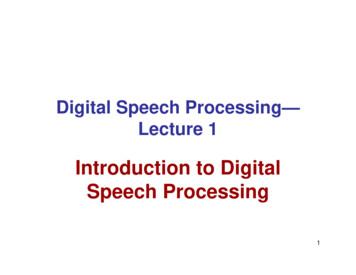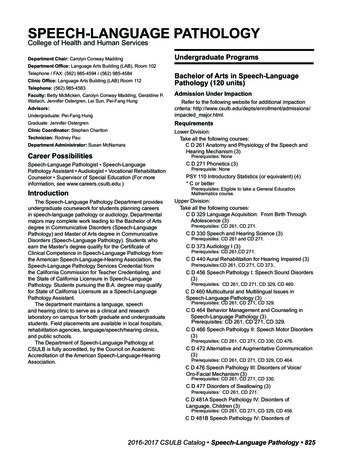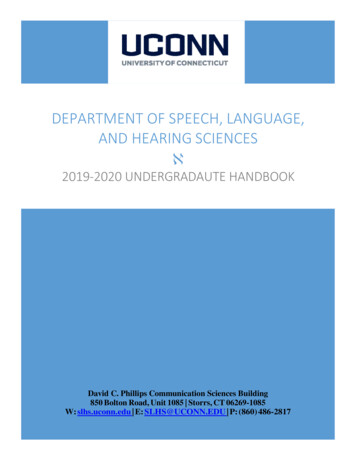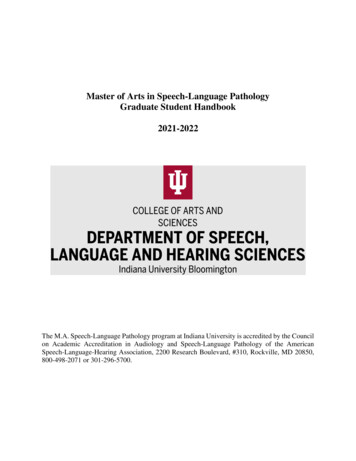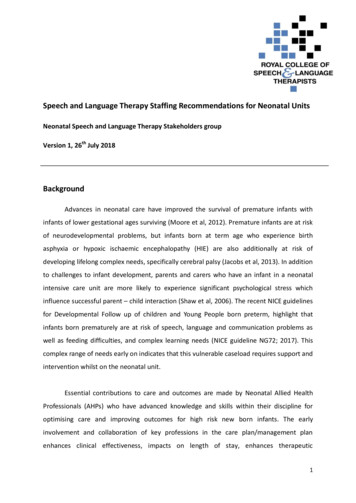
Transcription
Speech and Language Therapy Staffing Recommendations for Neonatal UnitsNeonatal Speech and Language Therapy Stakeholders groupVersion 1, 26th July 2018BackgroundAdvances in neonatal care have improved the survival of premature infants withinfants of lower gestational ages surviving (Moore et al, 2012). Premature infants are at riskof neurodevelopmental problems, but infants born at term age who experience birthasphyxia or hypoxic ischaemic encephalopathy (HIE) are also additionally at risk ofdeveloping lifelong complex needs, specifically cerebral palsy (Jacobs et al, 2013). In additionto challenges to infant development, parents and carers who have an infant in a neonatalintensive care unit are more likely to experience significant psychological stress whichinfluence successful parent – child interaction (Shaw et al, 2006). The recent NICE guidelinesfor Developmental Follow up of children and Young People born preterm, highlight thatinfants born prematurely are at risk of speech, language and communication problems aswell as feeding difficulties, and complex learning needs (NICE guideline NG72; 2017). Thiscomplex range of needs early on indicates that this vulnerable caseload requires support andintervention whilst on the neonatal unit.Essential contributions to care and outcomes are made by Neonatal Allied HealthProfessionals (AHPs) who have advanced knowledge and skills within their discipline foroptimising care and improving outcomes for high risk new born infants. The earlyinvolvement and collaboration of key professions in the care plan/management planenhances clinical effectiveness, impacts on length of stay, enhances therapeutic1
interventions, helps avoid complications and improves longer term neurodevelopmentaloutcomes. Speech and language therapists play an important role in the assessment andmanagement of early oral development, specifically feeing and communication (Harding etal, 2014 ;2015).Following the Neonatal Critical Care Review (2017), staffing levels on neonatal unitshave been revised and more specific information regarding AHP staffing ratios has beenrequested. This aims to move away from previous staffing recommendations of ‘access toAHP input’ and towards more equitable services for neonatal units nationwide. Suchrecommendations will assist with the commissioning of new roles and services to ensure wecontinue to improve services and support for infants in neonatal units. This document aimsto address Speech and Language Therapy staffing recommendations for neonatal units.However it is important to consider that the safety and effectiveness of neonatal servicesand patient care is influenced by more than staffing numbers; patient needs, servicedelivery models and skill mixing impact on staffing required.Service planningNeonatal AHPs work together with neonatal teams to optimise care of babies and theirfamilies, using their own unique professional skills to enhance neonatal outcomes. At aservice level, collaborative working aims to achieve improved health outcomes, reducedcosts and improved patient experiences (Earnest et al, 2014).A collaborative multi-professional model of service planning strives to improve the infantand families neonatal experience and health outcomes during neonatal care reducing thepressure placed on community services to provide long term support. Effectivecollaboration between the neonatal team members enables neonatal SLTs to identifyinfants at risk and trigger necessary services (Dow et al. 2017).When neonatal AHPs are embedded within the neonatal team and roles are clearly defined,each professional is able to reinforce key elements of developmentally supportive care,whilst providing individualised therapeutic input in their specific key areas. This model oftransdisciplinary working avoids duplication of effort and efficient use of resources whilst2
enabling sharing of information, knowledge and skills to support optimal outcomes (Foley,1990, p.274).Service planning for high risk infants should be a continuum with the involvement of keyservices from admission, through to neurodevelopmental follow up with seamless access toearly therapeutic and educational interventions in the community (Liper and Huron, 2018).Role of the Neonatal Speech and Language TherapistNeonatal SLTs have a specific role in the early identification and management of feeding andswallowing difficulties. They can facilitate positive feeding experiences and support feedingdevelopment from the beginning of the parent and infant’s feeding journey to reduce therisk of known prolonged feeding difficulties (Hawdon at el, 2000, Migraine et al. 2013,Johnson et al. 2016). They have a role in assessment and management of and in supportingfamilies to promote effective early communication and interactions with their preterm andsick infants, improving early attachment and bonding and maximising speech, language andcommunication outcomes post discharge and beyond into adolescence (Van Noort-van derSpek et al, 2002, Foster-Cohen et al, 2007, Caskey et al, 2014, Rabie et al, 2016).Staffing ConsiderationsNational BenchmarkingA national benchmarking survey of SLT provision on neonatal units was carried out betweenOctober 2016 to October 2017 by the Royal College of Speech and Language Therapists(RCSLT) Neonatal SLT stakeholders group (RCSLT,2017). A detailed questionnaire wascirculated to neonatal units across the United Kingdom with 58 questions covering domainssuch as the level of care, funding, banding, clinical experience, clinical supervision, training,the multi-disciplinary team, medical specialities and the nature of therapeutic interventionsprovided. The questionnaire was developed in an electronic format on Survey Monkey.67 responded out of a total 190 units (35%). The low response rate may reflect the absenceof SLT in many neonatal services and the consequent inequity of access to Speech andLanguage Therapy support across the country. The data collected provided information3
about level of unit, funding, staffing levels, access to supervision and the scope of clinicalpractice.The results showed significant discrepancies in provision locally and nationally (see CaseStudy One).Case StudyHospital A and B are two similar level three neonatal units based in different parts of thecountry. The table below shows the number of admissions and bed base for each unit.Although the characteristics of both hospitals are comparable, SLT provision is markedlydifferent in terms of staffing (1.2WTE vs 0.6WTE) and banding (band 8 vs band 7). This is anindication of the national picture.HospitalAdmissionsITU cotsHDU cotsSCBU cotsWTE SLT provision(amount and level)A(Eastof 7501515101.2 Band 8a(South 7081212120.6 Band 7England)BLondon)RecommendationsRecommendations are based on the type of neonatal unit (SCBU, LNU, NICU, NICU ) andnumber of cots using benchmarking and best consensus opinion. A calculation wasdeveloped for how much whole time equivalent (WTE) of speech and language therapyprovision is required per service. The following process was used to create the calculation:1.Raw data collected from the survey results2.Data formatted to extract the key fields (type of unit, number of cots, and WTE’s time)3.Data normalised to take out human interpretation and allow for correlation4.Total number of cots combined with WTE time for each type of unit across all unitssurveyed4
5.Total WTE time divided by the total number of cots to give an average WTE per cot(completed separately for each type of neonatal unit)6.Number of cots in a given unit multiplied by the average for that type of unit tocalculate the WTE (*see below)The calculation’s viability was tested by member of the Royal College of Speech andLanguage Therapists Neonatal SLT stakeholders group consisting of neonatal SLTs across theUK. SLTs were asked to compare the recommended calculations of WTE time with thecurrent WTE time in their units, this was generally accepted an appropriate amount of SLTinput.When planning staffing levels for speech and language therapy, the following should betaken into consideration:1. Number and acuity of cots on the unit.2. Specialities involved and likely input from Speech and Language Therapy e.g. cardiac,surgical, neurology, ear, nose and throat (ENT) may require significantly morestaffing.3. The positioning of transitional care within services. Transitional care cots may comeunder neonatal teams in some hospitals and this would influence staffingcalculations produced.4. Skill mix of staff to ensure adequate clinical supervision, training and successionplanning.5. Operational Delivery Network status and provision of support to other units withinthat network.6. The ability to provide cross cover for annual and study leave.7. Involvement in developmental care / family integrated care8. Involvement in staff trainingThe provision of outpatient clinics e.g. Hospital based neurodevelopmental follow-up,complex feeding clinics has not been included in these calculations. Additional fundingwould be necessary for SLT input.5
Neonatal Intensive Care Unit (NICU) ‘tertiary centre’1. Band 8 Clinical Lead in Neonatology (working at or towards Consultant leveldysphagia practitioner on Royal College of Speech and Language Therapists ‘RCSLT’Neonatal competencies).2. Level 3 calculator to help determine WTE SLT provision (based on number of cots,see below).3. WTE calculation needs to prioritise Band 8 time but may include Band 7 and Band 6when clinically competent.4. Band 6 posts must work alongside a Band 7 or above.5. SLT post holders must have access to appropriate clinical supervision (whetherinternal or external).Calculation:Number of cots X 0.04 WTE of SLT provision required*An additional 0.02 per transitional cot would be needed for units where transitionalcare is included.Local Neonatal Unit (LNU)1. Band 7 Highly Specialist Speech and Language Therapist in Neonatology/PaediatricDysphagia (working at/towards Specialist level dysphagia practitioner on the RCSLTNeonatal Competencies).2. Level 2 calculator to help determine WTE SLT provision (based on number of cots,see below).3. Band 6 posts must work alongside a Band 7 or above.SLT post holders must have access to appropriate clinical supervision (whetherinternal or external).Calculation:Number of cots X 0.03 WTE of SLT provision required6
*An additional 0.02 per transitional cot would be needed for units where transitionalcare is included.Special Care Baby Unit (SCBU)1. Band 7 Highly Specialist Speech and Language Therapist in Neonatology/PaediatricDysphagia (working at/towards a Specialist level dysphagia Practitioner on the RCSLTNeonatal Competencies).2. Level 1 calculator to help determine WTE SLT provision (based on number of cots,see below).3. Band 6 posts must work alongside a Band 7 or above.Neonatal SLT post holders must have access to appropriate clinical supervision (whetherinternal or external).Calculation:Number of cots X 0.02 WTE of SLT provision required*An additional 0.02 per transitional cot would be needed for units where transitionalcare is included.CompetenciesSince the recommendations for neonatal AHP provision were produced by the Departmentof Health’s ‘Toolkit for High Quality Neonatal Care’ (2009) the demand for neonatal speechand language therapy has increased. During this time, specific neonatal SLT competencieshave not been available to ensure therapists working on neonatal units were able to providea consistent standard of care.A set of competencies for neonatal therapists working within the neonatal setting havebeen developed in consultation with stakeholders, to ensure all infants receiving SLT inputwithin the neonatal period receive an equal standard of care. They have been developed in7
conjunction with the RCSLT and are an extension of the current general paediatric dysphagiacompetencies to reflect the advanced practice level and specialist nature of working with aneonatal population. The competencies are currently undergoing their final edit.The competencies outline the essential knowledge and skills needed by an SLT workingwithin the neonatal setting and provide a framework of how to achieve these. It also offersvaluable guidance on the training of SLTs into the field of neonatal care, an integral part ofsuccession planning within all neonatal units.According to the national neonatal SLT benchmarking data, the majority of posts wereeither Band 8 or 7 (90%). There were a minority of Band 6 posts, but all worked alongside aBand 7 or above. The level of banding is a reflection of the specialist field but proves to belimiting when considering the small number of trained neonatal SLTs and the need forsuccession planning with the band 6 population. In consultation with the neonatal SLT, thereis a need for neonatal units to develop clear succession plans with teaching opportunitiesfor Band 6 posts who should work alongside band 7/8 clinicians. This is vital for ensuring thetraining of specialists for the future.SupervisionThe inclusion of speech and language therapy in the multidisciplinary team is vital in theprovision of neonatal care. It is considered an advanced practice sub specialty area withinpaediatric speech and language therapy (BAPM, 2012). According to the national SLTneonatal benchmarking project, 85% of SLTs who responded receive formal supervision.Band 8 neonatal SLTs currently have fewer options for clinical supervision, particularly inareas of the country with less SLT provision. However, where sought, peer supervision is apossible option.Due to the limited availability of trained neonatal SLTs to providesupervision, SLTs may receive this in-house or seek support externally. Only 3% of responsesreceived supervision funded by neonatal services. Other SLTs self-funded or were coveredby paediatric SLT acute or community SLT budgets. This highlights the need for clinicalsupervision time be written into policies, procedures and future business cases.There is no national-prescribed frequency or duration of supervision. However, the CareQuality Commission (CQC) requires that supervision should take place regularly and the8
frequency and duration should be adequate to ensure safe and complete care for peoplewho use services (CQC, 2013).The RCSLT recognises that the intensity of supervision can change as the speech andlanguage therapist develops their expertise, goes through transitional periods or extendsthe demands of their work and roles (RCSLT, 2017).The following recommendations are based on RCSLT best practice guidance and bestconsensus opinion:Banding of SLTMinimum amount of time CommentsrequiredBand 6 (SLT in training)1 hr/weekly during the first 3 1:1months; 1 hourly/monthlythereafterBand 7 (experienced SLT)1-1.1.5 hrs/every 4-6 weeks1:1,group;peer;combination. The ed across differentform and is cumulative.Band 8 (experienced SLT)1-1.1.5 hrs/every 4-6 ,skypeorteleconference.Theminimum time requirementforsupervisioncanbedistributed across differentform and is cumulative.9
Education and TrainingThere are currently a number of short courses that are run in the United Kingdom whichprovide a basic introduction to SLT assessment and management of swallowing and feedingdifficulties in the neonatal population. Alongside the introduction of the competencies,there will be a review of the available courses to ensure that therapists can develop theirclinical skills to an advanced level of practice. Currently, when courses are not available, lessexperienced therapists should be trained in-service by band 7 and 8s. Given the shortage ofcurrent SLT coverage in neonatal units, as well as the lack of funded hours, the requiredtraining of band 6s would be unachievable. In order to make time for training of newneonatal SLTs, it is anticipated that more funded hours on neonatal units are needed forthose already in post and when considering the creation of future posts. Band 6’s in trainingwould need to be supernumerary until adequate competencies can be demonstrated.In response to the new staffing level recommendations, an RCSLT Neonatal education andtraining working group are carrying out a national review of continued professionaldevelopment opportunities for SLTs moving into neonatal care. In addition to the newneonatal competencies and short courses, therapists are expected to attend the RCSLTNeonatal SLT Clinical Excellence Network and carry out self-directed training.Neonatal Speech and Language Therapy Operational Delivery Network roleDue to the wide variation of neonatal SLT provision across the UK, there are currently nospecific national SLT guidelines regarding how Operational Delivery Network support isoffered and how much time should be allocated. This has resulted in many neonatal SLTsusing their own clinical time to provide unfunded support to local Speech and LanguageTherapists in the form of clinical supervision. Additional unfunded time has been offered tosupport local neonatal SLTs with training and education. Where a specific Neonatal Speechand Language Therapy Operational Delivery Network role exists, the job description hasbeen shaped by the needs of the network. This document endorses this strategy to ensurethat support is individualised and beneficial for each ODN.10
It is recommended that time allocated to a Neonatal Speech and Language TherapyOperational Delivery Network role is in addition to clinical time allocated per unit.Therapists in this role would ideally have a clinical component in addition to this role.General requirements of job descriptionPerson specificationEssential elements of person specification: Minimum 0.3 WTE neonatal speech and language therapist per 10,000 births. Band 8 Consultant neonatal speech and language therapist (as specified in theSpeech and Language Therapy Neonatal competencies).Essential components of job description: Develop and disseminate standardised collaborative guidelines that support bestpractice in neonatal care. Guidelines are under continual review to ensure bestpractice is implemented and standardised across the network. Support colleagues to meet complex needs of newborn infants and their parentswherever they may be within the network. Specifically where the therapist needsadditional specialist advice which has not been provided in standardised evidencebased practice guidelines.This may include providing second opinions wererequested by the unit neonatal SLT. Support education, identify and resource training needs for individual units.Education is provided at many levels locally including support with inductiontraining, neonatal nursing courses, cotside teaching, ward rounds and up-skillingexisting medical, nursing & all NNU staff where needed.This would be incollaboration with the individual unit SLTs. The network neonatal SLT will present atnetwork meetings and events, national courses as requested. Provide clinical supervision to unit based speech and language therapists across thenetwork as required, to collaborate, support and promote equality and consistency11
of service delivery and best practice for the profession in each unit. The network SLTis also a member of national professional groups and they are available as a resourceof information for peers within the network. In summary the network SLT is a supernumerary role working alongside individualunit SLTs and with the wider MDT. The network SLT will provide teaching anddissemination, reading and imparting good practice, developing guidelines andstandardising care.References1. Browne, J., & Ross, E. (2011). Eating as a neurodevelopmental process for high risknewborns. Clinics in Perinatology, 38(4), 731-743. Doi:10.1016/j.clp.2011.08.00.2. Care Quality Commission. (2013). Supporting information and guidance: ocuments/20130625 800734 v1 00 supporting information-effective clinical supervision for publication.pdf3. Caskey M, Stephens B, Tucker R, et al. (2014). Adult talk in the NICU with preterminfants and developmental outcomes. Pediatrics, 133, 578–84.4. Department of Health Toolkit for High Quality Neonatal Services. (2009).http://www.dh.gov.uk/en/ Healthcare/Children/Earlyyears/index.htm 25. Dow, A, Ivey K, C & Shulman, B. (2018). The Future of Pediatric Speech-LanguagePathology in a More Collaborative World. Pediatric Clinics of North America, 65, 171177. 10.1016/j.pcl.2017.08.0296. Earnest M, Brandt B. (2014). Aligning practice redesign and interprofessionaleducation to advance triple aim outcomes. Journal of Interprofessional Care,28(6),497–500.7. Foley, G. M. (1990). Portrait of the arena evaluation: Assessment in thetransdisciplinary approach. In E. D. Gibbs & D. M. Teti (Eds.), Interdisciplinaryassessment of infants: A guide for early intervention professionals (271–286).Baltimore: Paul Brooks.12
8. Foster-Cohen S, Edgin JO, Champion PR, Woodward LJ. (2007). Early delayedlanguage development in very preterm infants: evidence from the MacArthur-BatesCDI. Journal of Child Language,34(3),655–675.9. Harding, C., Frank, L., Botting, N., & Hilari, K. (2015). Assessment and management ofinfant feeding. Infant, 11(3), 85-89.10. Harding, C., Frank, L., Van Someren, V., Hilari, K., & Botting, N. (2014). How doesnon-nutritive sucking support infant feeding? Infant Behavior and Development,37(4), 457-464.11. Hawdon JM, Beauregard N, Slattery J, Kennedy G (2007) Identification of Neonatesat Risk of Developing Feeding Problems in Infancy. Developmental Medicine andChild Neurology,42(4),235-239.12. Jacobs, S. E., Berg, M., Hunt, R., Tarnow‐Mordi, W. O., Inder, T. E., & Davis, P. G.(2013). Cooling for newborns with hypoxic ischaemic encephalopathy. The CochraneLibrary.13. Johnson S., Matthews R., Draper ES., Field DJ., Manktelow B., Marlow N., Smith LK.,Boyle EM.(2016). Eating difficulties in children born late and moderately preterm at2 years of age: a prospective population-based cohort study. The American Journal ofClinical Nutrition, 103(2), 406-414, https://doi.org/10.3945/ajcn.115.12106114. Kirk, A.T., Alder, S.C., & King, J.D. (2007). Cue-based oral feeding clinical pathwayresults in earlier attainment of full oral feeding in premature infants. Journal ofPerinatology, 27(9), 572-278.15. Lipner H, Huron R. (2017). Developmental care of the pre-term infant: from NICUthrough high-risk infant follow-up. Pediatric Clinics of North America, 65(1),135-141.16. Migraine A., Nicklaus SA., Parnet P., Lange C., Monnery-Patris R., Sandrine., ClotildeDes R., Darmaun D., Flamant DC., Amarger V., Roze, C-J. (2013). Effect of pretermbirth and birth weight on eating behavior at 2 years of age. American Journal ofClinical Nutrition, 97(6), 1270–1277. doi: 10.3945/ajcn.112.05115117. Moore T., Hennessy E.M., Myles J., Johnson S., Draper E.S., Costeloe K. & Marlow N.(2012). Neurological and developmental outcome in extremely preterm childrenborn in England in 1995 and 2006: the EPICure studies. British Medical Journal,345:e7961.13
18. National Institute of Health Care and Excellence. (2017). Developmental follow-up G72).www.nice.org.uk/guidance/ng72.19. Rabie NZ, Bird TM, Magann EF, Hall RW, McKelvey SS.(2015). ADHD anddevelopmental speech/language disorders in late preterm, early term and terminfants. Journal of Perinatology,35(8):660–4. doi: 10.1038/jp.2015.28. [PubMed:25836321]20. Royal College of Speech & Language Therapists. (2017). Information on .org/cq live/resources a z/supervision/information031721. Royal College of Speech & Language Therapists National Benchmarking Survey ofProvision to Neonatal Units in the UK, 2017.22. Service Standards for Hospitals Providing Neonatal Care (3rd edition) (2010). BritishAssociation of Perinatal Medicine.23. Shaw, R. J., Wamboldt, M., Bursch, B., & Stuber, M. (2006). Practice patterns inpediatric consultation–liaison psychiatry: a national survey. Psychosomatics, 47(1),pp 43-49.24. Van Noort-van der Spek IL, Franken MC,Weisglas-Kuperus N.(2012). Languagefunctions in preterm-born children: a systematic review and meta-analysis.Pediatrics, 129(4),745–754AuthorsAlexandra Connolly, Highly Specialist Neonatal Speech and Language Therapist, ImperialCollege Healthcare NHS Trust & Barts Health NHS TrustMichelle Sweeting, Highly Specialist Neonatal Speech and Language Therapist, Mid EssexHospital Services NHS TrustRebecca Murphy, Highly Specialist Neonatal Speech and Language Therapist, EvelinaLondon Children’s HospitalNicoll Bell, Highly Specialist Neonatal Speech and Language Therapist, Barking,Redbridge and Havering University Hospitals NHS Trust14
Katy Parnell, Highly Specialist Neonatal Speech and Language Therapist, BirminghamWomen and Children’s Foundation TrustEmma Foulerton, Advanced Neonatal Respiratory PhysiotherapistSouthern West Midlands Neonatal Operational Delivery Network15
Speech and language therapists play an important role in the assessment and management of early oral development, specifically feeing and communication (Harding et al, 2014 ;2015). Following the Neonatal ritical are Review (2017), staffing levels on neonatal units . funding, banding, clinical experience, clinical supervision, training, the .
